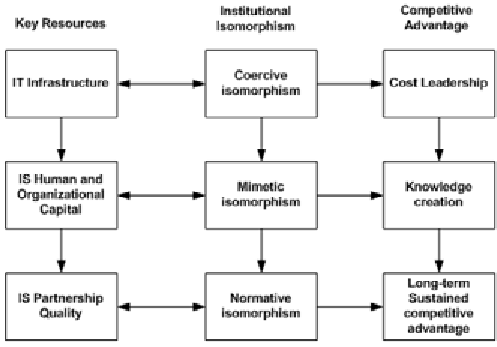Environmental Engineering Reference
In-Depth Information
Figure 2. Green IT strategies Generic Scheme
asymmetries, as well as involving uncommon
characteristics. These asymmetries (Miller, 2003,
pp. 964): “skills, processes, talents, assets, or
outputs an organization possesses or produces
that its competitors do not and cannot copy at a
cost that affords economic rents”, should be con-
verted into valuable resources or core capabilities
by exploring and discovering the asymmetries,
turning asymmetries into capabilities by strategi-
cally imbedding them within organization design
configurations, and matching asymmetry-derived
capabilities to market opportunities. The relation-
ship and path dependency of key resources and
competitive advantages is illustrated in Figure 2.
A resource market imperfection may be exog-
enous, in the sense that it results from the firm's
possession of some superior physical, organiza-
tional or intangible resource that has accumu-
lated as a consequence of the firm's unique his-
torical evolution (Lockett
et al
., 2009). IT alone
does not explain variations in firm performance
measures, but its advantages are gained via their
ability to combine explicit technology resources
with complementary human and business re-
sources (Jeffers
et al
. 2008). Skills and knowledge
are critical to the success of new technology adop-
tion (Cohen and Levinthal, 1990). Pollution-re-
duction technologies have evolved from readily
available, non-value-added pollution control
devices to more complex plant infrastructures
equipped with environmental technologies
(Nehrt, 1996). After a firm has benefited from the
initial implementation, further reductions in ex-
ternal processes frequently demand more complex
transformation processes or even wholly new
technologies, the implementation of which is of
course also more complex (Hart 1995). As the
firm initiates efforts to modify these processes by
incorporating newer and more complex tech-
nologies, it creates or acquires tacit knowledge.
This form of knowledge has been identified as a
critical factor in the successful use of IT to achieve
business objectives (Jeffers
et al
. 2008). Such
knowledge cannot be readily copied if the firm
relies on historical precedents (path dependency)
or is ambiguous and subtle (Miller, 2003). Because
IT skills or knowledge are developed over long
periods of time, the development of these skills
is often a path-dependent and socially complex
process (Ray
et al
., 2004). To the extent that this
shared knowledge is valuable and distributed
heterogeneously across firms, it may function as
a source of competitive advantage (Ray
et al
.,
2004). Thereby, distinctive processes, environ-
ment-specific devices, and knowledge ties may

